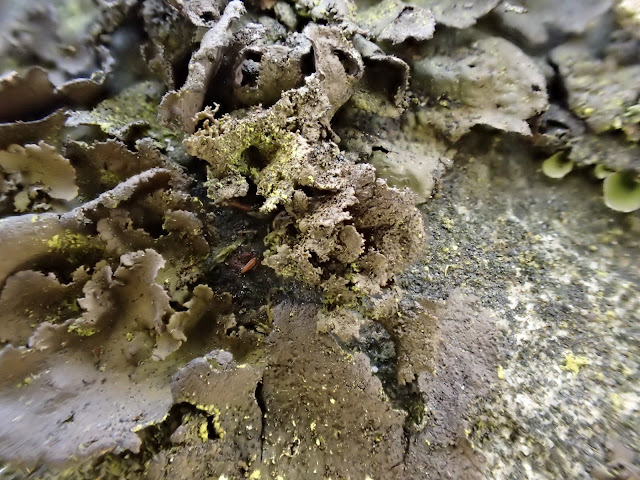This follows on from Lichens at Cober Hill BLS Winter Meeting 2024 part 1
On the Sunday afternoon a small group of us led by Neil Sanderson went to look at some heathland at Jugger Howes moorland.
On the Sunday afternoon a small group of us led by Neil Sanderson went to look at some heathland at Jugger Howes moorland.
 |
| Cladonia callosa |
 |
| Cladonia coccifera s.s. C coccifera has very wide shallow cups. On the podetia there are just granules, not squamules. |
 |
| Baeomyces rufus again |
 |
| bund to stop water and soil flow I suppose. |
Musings on Location.
There was an old concrete "road" left from the days it was a training place in the second world war over 75 years ago That made walking easy for us and provided extra habitat for different species. We were at the "summit" of the plateau at 210m above sea level (and only 4km (3miles) away from the sea
It also led us not just into a new monad or even 10 km square but into a new 100km square - from NZ9400 to SE9499.
Also - if Britain is divided into two, as happens in the Geology map of Britain, we step from the northern half in NZ9400 (where we parked the car) to the "summit" in SE9499.
I see that the water that drains from where we are standing down a kilometer into Judder Howe Beck that flows into the Derwent -- that then cuts a narrow valley south to Hackness then south through the Forge Valley to the Vale of Pickering .. then flows SW almost to York, then turns south through the Derwent Ings to join the river Ouse at Drax Power station.
 |
| Rhizocarpon (most likely) petraeum on concrete road through heathland |
 |
| Trapeliopsis placodioides - with soralia and turns C red. (see dot) |
We were pleased to find not just one, but three species of Umbilicaria. This likes acid rocks and clean air.
 |
| Umbilicaria on a flat boulder |
 |
| Umbilicaria |
 |
| Umbilicaria |







